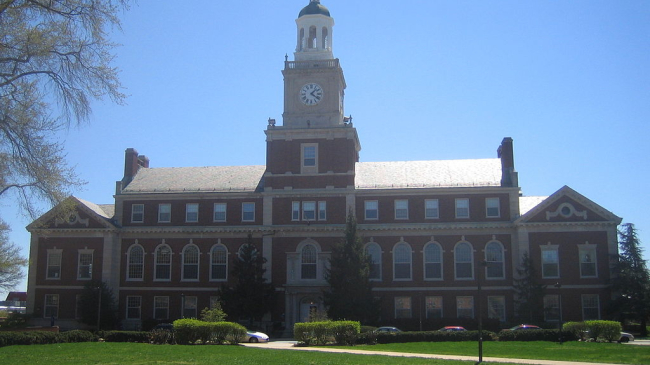On February 17, 2013, the NOAA Center for Atmospheric Sciences (NCAS) located at Howard University co-sponsored an open house aboard the NOAA ship Ronald H. Brown in San Juan, Puerto Rico.

AEROSE team posing about the NOAA vessel Ronald H. Brown include Vernon Morris, far right, and Everette Morris, third from right, both of NCAS at Howard University ,and NOAA scientist Claudia Schmid, front row, green jacket. (Image credit: NCAS)
Students and faculty from local universities, including the University of Puerto Rico, Mayaguez, the University of Puerto Rico, Rio Piedras and the Universidad Metropolitana, as well as staff from the National Weather Service San Juan Weather Forecast Office and guests were hosted from 1:00 - 3:00 PM aboard the vessel. The open house was comprised of a tour of the ship facilities, a showcasing of the science labs, and a brief exposition on the scientific research.
The NOAA ship Ronald H. Brown is a floating research laboratory capable of supporting interdisciplinary science experiments throughout the global oceans. The ship reached the port of San Juan after completing a mission entitled Pilot Research Moored Array in the Tropical Atlantic North East Extension (PNE)/ AERosols and Ocean Science Expeditions (AEROSE). PNE/AEROSE is a joint collaboration between NOAA′s Atlantic Oceanographic and Meteorological Laboratory (AOML) and NCAS which is designed to monitor and study the climate of the tropical Atlantic using a variety of atmospheric and oceanographic probes.
The PNE, led by AOML scientists, was the primary mission of the cruise and is part of a three-party project between Brazil, France and the United States that monitors the upper ocean and near surface atmosphere of the Tropical Atlantic via the deployment and maintenance of an array of moored buoys and automatic meteorological stations. During the cruise, four moorings were serviced and an extensive series of oceanographic profiling casts were conducted.
AEROSE, led by NCAS and NOAA/NESDIS scientists, investigated the transport, evolution, and impact of West African air masses, with a focus on Saharan air, in the tropics. Collaboration with NOAA/NESDIS/Center for Satellite Applications and Research (STAR) represents an important component of AEROSE which is part of NOAA's Satellite Environmental Data Record (EDR) Product Validation effort. This collaboration involved critical ground-truth validation measurements to support the calibration, validation, and improvement of advanced satellite retrievals and data products including the NOAA R-Series Geostationary Operational Environmental Satellite (GOES-R), and the new Suomi National Polar-orbiting Partnership (NPP) Cross-track Infrared Microwave Sounding Suite (CrIMSS).
During this research mission, the AEROSE team also collected a variety of ambient air filters of bioaerosols and particulate. In addition to the collaborative research with NOAA scientists, NCAS provided research training experiences for four graduate students from the NCAS and CREST Cooperative Science Centers, which are funded through the NOAA Educational Partnership Program.
The PNE/AEROSE partnership represents a synergistic and cost effective collaboration for NOAA. AEROSE, by deploying with PNE, adds value and increases the return on NOAA's investment in the application of this research platform. This is the eighth full mission of AEROSE aboard the Ronald H. Brown.



